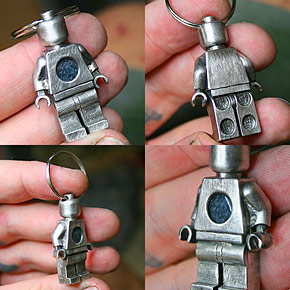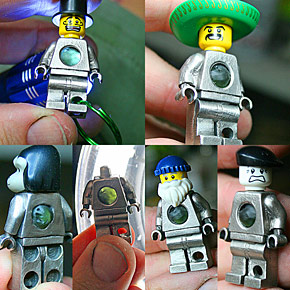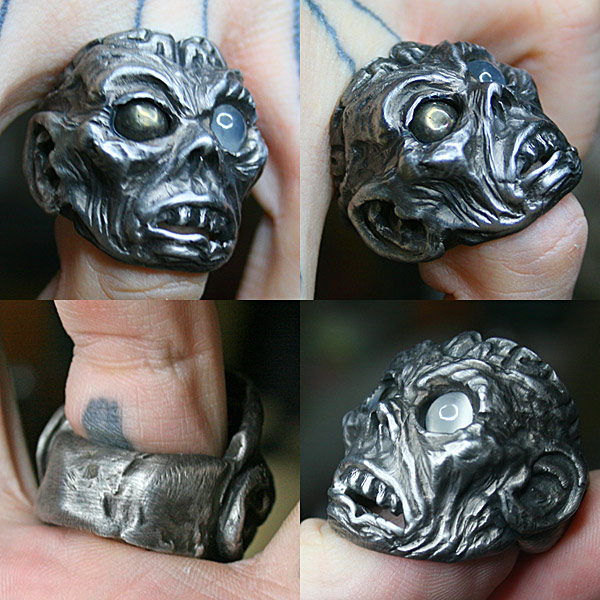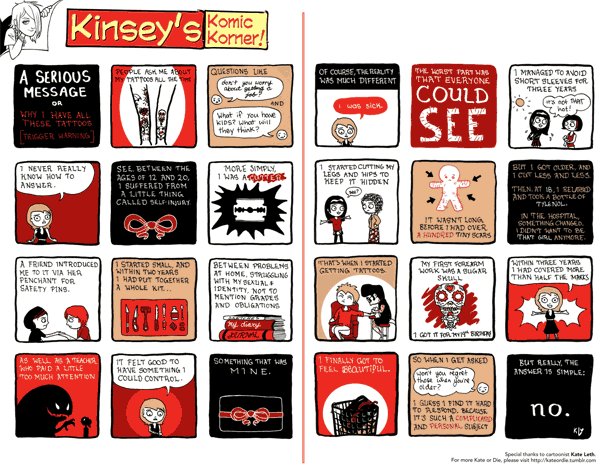First of all, my daughter had her (very expensive) belly xrays results but I don’t know the results yet. It went well and her and her mother celebrated successfully drinking the miserable tracer chemicals by going bowling, so at least that means she is not teetering on the edge of death I hope. Although I watched a wonderful puppetry documentary last night that included the shockingly sudden death of Jim Henson as part of the story, so I have surprise misery on the paranoid mind I suppose.
Second, thanks again to everyone who’s supporting me paying off the shocking hospital bills by grabbing goodies on my Etsy store, and as I expected the minifig I posted yesterday disappeared within minutes. So I used up the last of my metal today making (among other things) two more, one that’s got a pretty druzy quartz in it, and the other that’s got out-of-this-world (literally) Libyan desert glass — and is headless so you can swap on whatever strikes your fancy. Click ‘em for bigger pictures and to jump to their page on the shop.
Selfishly I don’t want to say “but first check out my competition”, but I do want to recommend someone that’s making very similar pewter items to me, but to be honest, he’s obviously more experienced than me and is working with great precision — so for example, when he makes a pewter Star Wars minifig, he casts every little bit separately! Wow! His whole store, “Renaissance Man Fabrication“, is actually full of very nice precision casting which he says he’s doing by hand so I assume he’s using very similar methods to me.
What really shocks me though are his prices — he’s selling some sculptures, earrings with hoops and incredibly detailed pewter castings that have been beautifully finished with a nice patina, for as low as $5. Even his multi-piece minifig, which have tons of separate pieces go for $50. That’s the biggest thing that upsets me about Etsy — artisans undervaluing their work, often radically. I know what it takes to make these items. On some of them he is barely breaking even, and when you factor in his time, there are quite a few items that he’s got to be making well under minimum wage for. And it’s not just him — this is a terrible trend that’s common on Etsy and other online vendors.
I don’t know if it’s a belief that hand-made first-world artisans need to compete on price with mass-manufactured Chinese knockoffs (these “fake handmade” items are way too common on Etsy, as is regularly pointed out — to deaf corporate ears — on Regretsy in their “Not Remotely Handmade” and “Compare and Save” categories), or if it’s a need to compete with hobby crafters who are only looking to break even to pay for something they enjoy doing, or if it’s deranged cutthroat pricing that has just become status quo, but it’s a big mistake. Artisans who dedicate themselves to creating handmade jewelry and art deserve as much as anyone else to make a living wage. How is someone supposed to have a life — pay for a family, pay for a vehicle, pay for a home, and so on — when they’re valuing their time at a couple dollars an hour? They’d make more working at a fast food joint. It should not be a sacrifice for someone to choose to live off their skills and create products people care about. Unfortunately though, in general the entire community — all the creators, and the consumers, have to be willing to accept it for anything to change, or even this little world of makers and crafters will fit the mold that has the so-called “1%” cackling all the way to the bank.
When I price an item, I come up with the number by first figuring out what the materials cost me. That includes working in wastage, breakage, a certain percentage of unsold items, cost of making tooling and molds, and so on — a true assessment. I come up with a number that not only would allow me to replace the item at cost, but get a little bit more raw materials so I can expand what I offer. Then I figure out how long it takes me to make the item, including secondary things like making the tooling, creating the online shop listing, and packing and shipping the item. From that I put in a value based on what I think is a fair wage for myself for this item based on what I need to make to live, and what special skills or vision I feel I bring to this item (for example, deciding whether I am simply a craftsman or whether I have made some sort of profound artistic statement that has inherent value). Generally these two main categories (materials + labor) break down in such a way that I have enough wiggle room on the pricing that I can offer up to 50% off and still break even on everything (ie. the materials are covered). In my case this is important because of my “pay what you can” pricing scheme, where people can choose to apply up to a 50% off discount on every order, at their discretion.
If you’re wondering how that experiment is going, it’s going well. About half of the people ordering don’t use a coupon. Many that do send a very nice thank-you note so I’m happy to have been able to get my work into the hands of people who seem to care about it — that is very fulfilling as a maker I think — and many even say that they will in the future “pay me back” which is wonderful because it shows me that people really do appreciate the time and effort that goes into making these items. I just wish everyone valued their time, and that the “maker/crafter community” as a whole took a stand for fair living-wage pricing. Like I said, we shouldn’t have to sacrifice our well-being to provide unique hand-made items to the public.



















